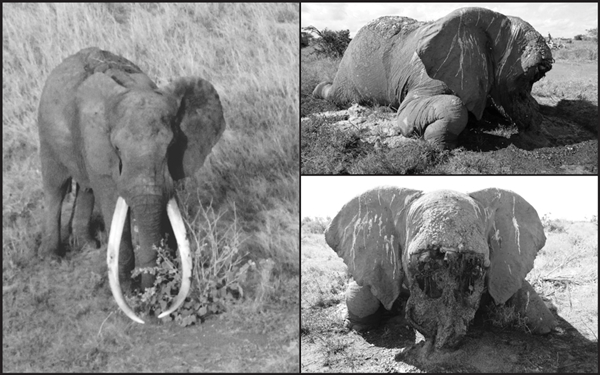World's biggest elephant killed by poachers in Kenya
 0 Comment(s)
0 Comment(s) Print
Print E-mail China.org.cn, June 16, 2014
E-mail China.org.cn, June 16, 2014
A 50 year-old elephant named Satao, one of the world's largest elephants, has been shot dead by ivory poachers' poisoned arrows in Kenya.
|
A 50 year-old elephant named Satao, one of the world's largest elephants, has been shot dead by ivory poachers' poisoned arrows in Kenya. [Photo/Tsava Trust] |
"Today it is with enormous regret that we confirm there is no doubt that Satao is dead, killed by an ivory poacher's poisoned arrow to feed the seemingly insatiable demand for ivory in far off countries," according to a statement released by Tsavo Trust, a Kenyan non-profit organization working in support of wildlife.
"The arrow had entered his left flank and he stood no chance of survival. We spotted his carcass on 2nd June but to avoid any potential false alarms, we first took pains to verify the carcass really was his," the statement said.
Satao was one of the last surviving "great tuskers", elephants that nearly reached the ground. This magnificent elephant was widely known in Tsavo East National Park, where he was observed with awe by many thousands of Tsavo's visitors over the years.
The statement said for the last 18 months, Kenya Wildlife Service (KWS) and Tsava Trust jointly monitored Satao's movements using aerial reconnaissance, and KWS deployed ground personnel in his known home range. But with today's mounting poaching pressures and anti-poaching resources stretched to the limit, it proved impossible to prevent the poachers getting through the net.
According to a report released last week by the Convention on International Trade in Endangered Species of Wild Fauna and Flora (CITES), over 20,000 African elephants were poached for their tusks in 2013.
Although the sharp upward trend in illegal elephant killing observed since the mid-2000s, which had peaked in 2011, is levelling off, poaching levels remain alarmingly high and continue to far exceed the natural elephant population growth rates, resulting in a further decline in elephant populations across Africa.
"The momentum generated over the past three years must now translate into deeper and stronger efforts to fight these crimes on the front line, where it is needed most -- from the field, to Customs, to illicit markets, and only then can we hope to reverse the devastating poaching trends of the past decade," said John E. Scanlon, Secretary-General of CITES.







Go to Forum >>0 Comment(s)